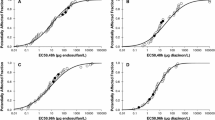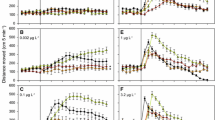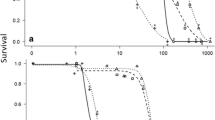Abstract
Pesticides sprayed on farmlands can end up in rivers and be transported into estuaries, where they could affect aquatic organisms in freshwater and marine habitats. A series of experiments were conducted using the amphipod Corophium volutator Pallas (Amphipoda, Corophiidae) and single pesticides, namely atrazine (AT), azinphos-methyl (AZ), carbofuran (CA) and endosulfan (EN) that were added to sediments and covered with seawater. Our goal was to compare the concentrations affecting the survival of the animals relative to potential attractant or repellent properties of sediment-spiked pesticides. The avoidance/preference of contaminated/reference sediments by amphipods was examined after 48 and 96 h of exposure using sediments with different organic carbon content. The octanol–water partition coefficients (log Kow) ranked the pesticides binding to sediments as EN > AZ > AT > CA. LC50 and LC20 covered a wide range of nominal concentrations and ranked toxicity as CA-AZ > EN > AT. Under the experimental set up, only EN initiated an avoidance response and the organic carbon normalised concentration provided consistent results. Using the present data with wide confidence limits, >20% of a population of C. volutator could perish due to the presence of EN before relocation or detecting CA or AZ in sediments by chemical analysis.


Similar content being viewed by others
References
Ankley GT, Call DJ, Cox JS, Kahl MD, Hoke RA, Kosian PA (1994) Organic carbon partitioning as a basis for predicting the toxicity of chlorpyrifos in sediments. Environ Toxicol Chem 13:621–626
Bergamaschi BA, Kuivila KM, Fram MS (2001) Pesticides associated with suspended sediments entering San Francisco Bay following the first major storm of water year 1996. Estuaries 24:368–380
Borgmann U (2005) Sediment toxicity testing with the freshwater amphipod Hyalella azteca: relevance and application. Chemosphere 61:1740–1743
Chapman PM (1986) Sediment quality criteria from the sediment quality triad. An example. Environ Toxicol Chem 5:957–964
Chapman PM (2007) Determining when contamination is pollution—Weight of evidence determinations for sediments and effluents. Environ Int 33:492–501
Chapman PM, Hollert H (2006) Should the sediment quality triad become a tetrad, a pentad, or possibly even a hexad? J Soils Sediments 6:4–8
Chapman PM, Swartz RC, Roddie B, Phelps HL, van den Hurk P, Butler R (1992) An international comparison of sediment toxicity tests in the North Sea. Mar Ecol Prog Ser 91:53–264
De Bruin J, Busser F, Seinen W, Hermens J (1989) Determination of octanol/water partition coefficients for hydrophobic organic chemicals with the ‘slow-stirring’ method. Environ Toxicol Chem 8:499–512
Delle Site A (2001) Factors affecting sorption of organic compounds in natural sorbent/water systems and sorption coefficients for selected pollutants. A review. J Phys Chem Ref Data 30:187–439
DeLorenzo ME, Scott GI, Ross PE (2001) Toxicity of pesticides to aquatic microorganisms: a review. Environ Toxicol Chem 20:84–98
Dunn AM (2004) A relative risk ranking of pesticides used in Prince Edward Island. Environment Canada, Dartmouth, NS. Report EPS-5-AR-04-03. p 41
EC Environment Canada (2005) Guidance document on statistical methods for environmental toxicity tests EPS 1/RM/46, pp 241, section 4
Esselink P, van Belkum J, Essink K (1989) The effect of organic pollution on the local distribution of Nereis diversicolor and C. volutator. Neth J Sea Res 23:323–332
Fisher SW, Lydy MJ, Berger J, Landrum PF (1993) Quantitative structure–activity relationships for predicting the toxicity of pesticides in aquatic systems with sediment. Environ Toxicol Chem 12:1307–1318
Fuchsman PC, Barber TR (2000) Spiked sediment toxicity testing of hydrophobic organic chemicals: bioavailability, technical considerations, and applications. Soil Sed Contam 9:197–218
Hellou J, Steller S, Zitko V, Leonard J, King T, Milligan T, Yeats P (2002) Distribution of PACs in surficial sediments and bioavailability to mussels, Mytilus edulis, of Halifax Harbour. Mar Environ Res 53:327–356
Hellou J, Cook A, Ernst B, Leonard J, Steller S (2004) Pesticides in an estuary on Prince Edward Island, Canada. Proceedings of 6th bay of fundy ecosystem partnership workshop. Environment Canada, Atlantic Region, Occasional Report. 23:425–429
Hellou J, Cheeseman K, Jouvenelle ML, Robertson S (2005) Behavioural response of Corophium volutator relative to experimental conditions, physical and chemical disturbances. Environ Toxicol Chem 24:3061–3068
Hellou J, Cheeseman K, Desnoyers E, Johnston D, Jouvenelle ML, Leonard J, Robertson S, Walker P (2008) A non-lethal chemically based approach to investigate the quality of harbour sediments. Sci Tot Environ 389:178–187
Hughes RG, Horsfall IM (1990) Difference in the swimming behaviour of the amphipod Corophium volutator from different populations. J Mar Biol Assoc UK 70:143–148
Kamrin MA (ed) (1997) Pesticide profiles, toxicity, environmental impact and fate, Lewis Publishers. Boca Raton, FL, p 676
Krang A-S, Baden SP (2004) The ability of the amphipod Corophium volutator (Pallas) to follow chemical signals from con-specifics. J Exp Mar Biol Ecol 310:195–206
Kravitz MJ, Lamberson JO, Ferraro SP, Swartz RC, Boese BL, Specht DT (1999) Avoidance response of the estuarine amphipod Eohaustorius estuarius to polycyclic aromatic hydrocarbon-contaminated, field-collected sediments. Environ Toxicol Chem 18:1232–1235
Lawrie SM, Raffaelli DG (1998) In situ behaviour of the amphipod Corophium volutator (Pallas). J Exp Mar Biol Ecol 224:237–251
Mackay D (1991) Multimedia environmental models—the fugacity approach. Lewis Publishers Inc, Michigan, USA, p 257
Murdoch MH, Chapman PM, Norman DM, Quintino VM (1997) Spiking sediment with organochlorines for toxicity testing. Environ Toxicol Chem 16:1504–1509
Percy J (1999) Keystone corophium. Master of the mudflats. Fundy issues. Issue 13, p 10
Robinson PW (1999) The toxicity of pesticides and organics to Mysid shrimps can be predicted from Daphnia spp. toxicity data. Wat Res 33:1545–1549
Acknowledgements
We would like to thank our collaborators in this first year of the study, Mr. Lea Murphy, Deryck Mills, Delly Keen, John McKinnon, and Danny Geldert at DFO, PEI who facilitated our sampling in the Wilmot and Dunk Rivers, by providing a boat, GPS system, sampling experience and enthusiasm. We also wish to acknowledge funding from Health Canada through the Department of Fisheries and Oceans under the National Pesticide Research Fund.
Author information
Authors and Affiliations
Corresponding author
Rights and permissions
About this article
Cite this article
Hellou, J., Leonard, J., Cook, A. et al. Comparison of the partitioning of pesticides relative to the survival and behaviour of exposed amphipods. Ecotoxicology 18, 27–33 (2009). https://doi.org/10.1007/s10646-008-0253-6
Received:
Accepted:
Published:
Issue Date:
DOI: https://doi.org/10.1007/s10646-008-0253-6




